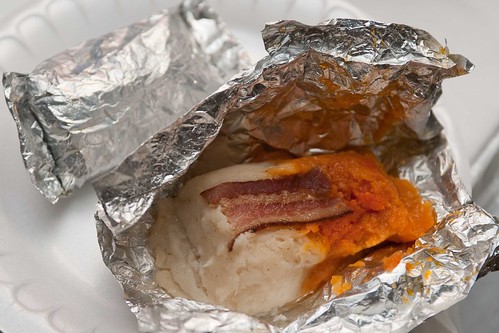Tamales Gisu: Red and White Tamales
Description
A variation of the more well-known Mexican tamale, this CHamoru version is characterized by its distinctive half white-half orange coloration.
History
Origin
In 1819 French explorer Louis Freycinet described a traditional way of preparing the local tamales from a bouillie (puree) of maize known as atolé mixed with pork or chicken, pimento, tomatoes and lard, as well as achote. These ingredients were then cooked in an oven and served on a banana leaf. It was a food served only on special occasions and with great ceremony.
The tamales gisu itself is made of corn meal and masa harina (corn flour) but each half is flavored differently. The orange half is colored by achote (annatto) seed extract and flavored with meat such as bacon or chicken. The white half represents the “starch” portion of the tamale and has no distinctive meat-flavor. Unlike Mexican tamales, which are wrapped in corn husks, tamales gisu are often presented at the fiesta table wrapped in aluminum foil or banana leaves.
Evolution
Tamales are traditionally made from corn. Throughout the Spanish era and even before World War II, corn was a major crop in the Marianas, occupying large parts of cultivated land. Corn was introduced to the islands by Spanish missionaries shortly after regular visits from Mexico to the Philippines began, and it quickly replaced other local food items. The corn was grown communally, and harvested at the end of June. Husking parties with friends and neighbors were occasions to tell stories and jokes, and turn a tedious chore into a good time. The corn would be husked and the grains left to dry on mats. Later, the corn would be ground using a mitåte or grinding stone (a tool also appropriated from Mexican culture).
The most popular use for ground corn was in the production of titiyas (tortilla), but corn was also boiled or roasted on the cob, or boiled with coconut milk. It is not clear when exactly CHamorus used the ground corn to form tamales, but presumably the same influences from Mexico that led to titiyas also led to the production of tamales as a popular food item.
The presence of a similar version of tamales in the Philippines (including the orange/white color) suggests that ideas about flavoring, preparation and presentation were shared as people traveled along the Manila-Acapulco-Marianas trade route. The annatto seeds used to color the tamales are from the pods of the Bixa orellana plant, which is found in many parts of Latin America and the Carribean, and is also used as a food coloring in those places.
Preparation
The white and orange parts of tamales gisu are formed separately, then wrapped together in a banana leaf, or more commonly, aluminum foil, and steamed. Served warm, tamales gisu makes a delicious side dish at the CHamoru fiesta table.
Placement on table
Tamales gisu falls into the traditional CHamoru food category of åggon, and is placed at the head of the table after the rice, bread and other starches. Other forms of tamales – mendi’oka (tapioca) or suni (taro)– are sweet, therefore placed in the dessert section.
Recipe
Tamales Gisu: Red and White Tamales
- Red portion:
- ¼ cup bacon, chopped
- ¼ cup garlic, chopped
- ¼ cup onions, chopped
Saute ingredients above and set aside. Mix the following ingredients in a separate bowl and add to the red portion, making it into a paste. Set aside.
- 2 cups achote (annatto) water*
- 2 cups cornstarch
- 2 cups of cornmeal
* Achote water is made by soaking annatto seeds in water. Annatto powder, produced in the Philippines is now available in stores.
- White portion:
- ¼ cup bacon, chopped
- ¼ cup garlic, chopped
- ¼ cup onions, chopped
Saute above ingredients and set aside. Mix the following ingredients and add to the white portion to make a paste.
- 2 cups masa harina (Mexican flour)
- 2 cups cornstarch water
Cut up foil into serving sized pieces and pour mixture (red and white portion side by side), fold foil, wrapping each tamale and freeze.
Steam before serving.
* Recipe by Judith Guthertz from Lepblon Fina’tinas Para Guam: Guam Cookbook, 1985.
Video
Watch more Fiesta Table video demonstrations here.

